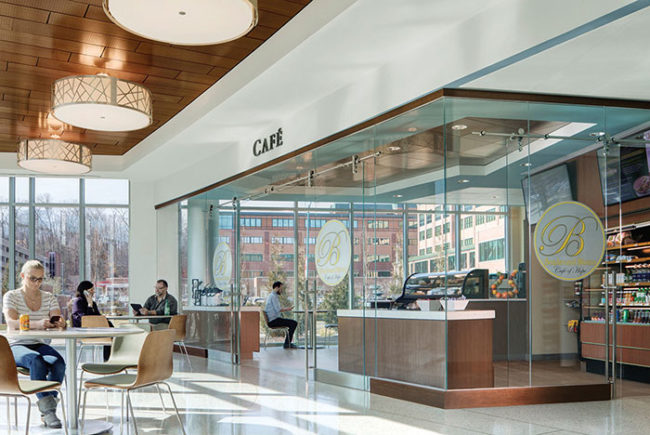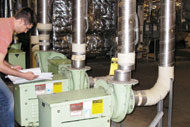Project Overview
Project Name United Hospital Center
Location Bridgeport, W. Va.
Total floor area (in square feet) 692,000
Number of floors 8
Number of beds 292
Project cost $282 million
Construction cost $196 million
Groundbreaking February 2004
Opening August 2010
Project Team
Owner United Hospital Center
Architectr Gresham, Smith and Partner
General Contractor Balfour Beatty Construction
Interior design, MEP and Structural engineering, and landscaping Gresham, Smith and Partners
One evening shortly after United Hospital Center (UHC), Bridgeport, W.Va., opened, hospital CEO Bruce Carter walked down the corridor of a patient unit and was struck by how quiet it was. In room after room, patients and visitors simply were watching the sun set.
It was a dramatic difference from the atmosphere of the hospital UHC replaced, where Carter says inpatients had trouble resting in cramped, semiprivate rooms; visitors bothered one another and at times outpatients were lined up in corridors on stretchers and in wheelchairs.
"We don't have that now," he says. "The facility works for patients."
Huge opportunity
The new building "is a huge opportunity for the hospital to start fresh," says David Stewart, AIA, NCARB, LEED AP, project designer for national architecture, engineering, interior design and planning firm Gresham, Smith and Partners (GS&P). "[Patients] feel like they're coming into a quality building where they know they're going to get good health care."
The hospital's exterior is divided into sections designed to break down the scale of the nearly 700,000-square-foot building. Curved, dark gray walls at the main entrance are backed by red brick that defines the major circulation routes; softer-gray brick and abundant exterior glass add a sense of lightness to the facility.
The main entrance opens onto a multistory mall that runs across the front of the building. "Any departments the public or outpatients need to access, they access from the mall," Carter explains. This design clearly separates public and clinical spaces, for added security and a more peaceful, private patient care environment. Several amenities are located along the mall, including the hospital chapel, gift shop, coffee bar — even a beauty spa.

Floor-to-ceiling exterior windows fill the mall with natural light and views of the healing garden. The natural scene outside is reflected by images of trees repeated along the interior walls.
Natural imagery is important to the design, says Jane Skelton, LEED AP BD+C, CSI, IIDA, EDAC, senior interior designer, GS&P. While the hospital wanted to be sleek and contemporary, it also needed to reflect the region's rural culture. Color, materials, textures and images from nature give the facility warmth.
Two-toned wood paneling evokes the regional, striated stone; wood soffits temper the modern look of the metal ceiling in the public mall. A glass tile wall behind the reception desk adds a boost of color.
Convenient design
Carter says the first-floor diagnostic and treatment area is designed to mimic an outpatient center. When patients enter the hospital, they are greeted and escorted to a bank of private registration rooms, and then on to the appropriate care area. An express testing department enables patients to stay in their own exam rooms while the necessary equipment, such as an X-ray or electrocardiograph machine, is brought to them. "You don't go from department to department. You don't register three times. You don't go up elevators. It's right there," Carter says.
The emergency department is located at one end of the mall and is laid out in four-bed pods surrounding a central nurse station. It includes an observation unit with 24 private rooms, a feature the former hospital lacked. According to Carter, patients under observation are managed better now that they can be cared for in their own unit.

The cancer center and a walkway to the adjacent medical office building are located at the opposite end of the mall.
The surgery, cardiovascular and critical care departments are collocated on the second floor. A 41-bay central prep area leads easily to the operating rooms, cardiac catheterization laboratories and endoscopy area. The operating rooms (ORs) are all at least 600 square feet in size, and one specialty OR, which includes radiology equipment, covers 1,200 square feet. An elevator is located near the recovery unit for direct access to the patient tower.
Efficient operations
The lower floors form a base for the patient tower, which extends up four additional floors. The patient rooms are arranged in 36-bed units with decentralized nurse stations and a central-service core.
Each patient bed is angled toward a large exterior window. This gives nurses a better view of the head of the bed from the corridor, and patients a better view outside. A racetrack layout ensures all rooms face outward, to make the most of the local scenery.
The medical-surgical rooms are standardized for safety, efficiency and flexibility in treating various patient types. The pediatric rooms have patterned ceiling tiles, but are otherwise designed the same as the standard rooms, to allow overflow cases to be treated in the pediatrics department.
A mechanical floor is located between the second and fourth floors. This promotes efficient care by enabling facilities staff to perform routine mechanical maintenance without interfering with clinical services, says David McMullin, principal and senior mechanical engineer, GS&P.
Room to grow
With the rooftop clear of mechanical systems, the patient tower can be extended two more floors with relative ease. The expansion plan calls for the additional floors to be powered by a second mechanical/electrical space to be built above them. This design will allow the hospital to expand without having to shut down or replace existing equipment, McMullin says.
A horizontal expansion plan is in place for the major diagnostic and treatment areas. These were all built on the building's perimeter so the hospital can grow in an orderly fashion, giving UHC patients, visitors, staff and physicians many more years of peaceful sunsets at this facility.
Amy Eagle is a freelance writer based in Homewood, Ill., who contributes regularly to Health Facilities Management magazine.
| Sidebar - Sloped hospital site offers natural charm |
| Due to the state's hilly terrain, "there aren't really a lot of sites in West Virginia; there's just land," says Ken Priest, AIA, NCARB, LEED AP; principal-in-charge, Gresham, Smith and Partners (GS&P). For construction, he says, "you just have to pick a location." The location of United Hospital Center (UHC) was chosen for its proximity to Clarksburg, W.Va., where many of the hospital's patients live, and Interstate 79; other factors were its size and natural beauty. This last feature is highlighted throughout the design. According to Bruce Carter, hospital CEO, about 2 million cubic yards of earth were excavated to create a flat bench for the hospital campus. In doing so, the builders carved out approximately 30 additional feet in front of the building footprint for a large healing garden. Patients and visitors cross over the garden on bridges as they enter the hospital, a design intended to reduce stress. The sloped hospital site allows natural light to enter lower-level spaces, including the dining area, classrooms and administrative offices. The building is sited to shade the exposed areas somewhat, giving the hospital the benefits of sunlight while controlling the heating and cooling load, says David McMullin, principal and senior mechanical engineer, GS&P. The retaining walls are terraced and landscaped with cascading plants to keep the walls from appearing monolithic. Sculpture is used throughout the area. Outdoor seating is available in the garden, as well as in waiting areas located off the surgery, critical care and oncology departments. The site is adjacent to that of the Federal Bureau of Investigation's Criminal Justice Information Services Division, which is buffered by a large security zone of meadows, trees and rolling hills. Carter says the hospital plans to protect its viewshed, not allowing any development that would block the sight of this natural landscape. |
| Sidebar - Parking is plentiful, but not overwhelming |
| Of all the advancements at United Hospital Center's replacement facility, one of the most important improvements is the parking, according to hospital CEO Bruce Carter. "Parking is a big deal to people," he says. "If you're 90 and you're on oxygen and can hardly walk, it's a big deal." The parking garage at the existing facility was in poor condition, giving patients an unpleasant first impression of the hospital. The new facility has ample surface parking that was carefully designed to prevent what Carter calls the "Walt Disney World problem," where the parking lot "goes for miles." Parking lots surround the hospital; separate entrances for the emergency department, main lobby and oncology department limit the walking distance from any one parking space. This design also gives cancer patients undergoing difficult treatments additional privacy and dignity as they enter and exit the building. At the main hospital entrance, there is a patient drop-off and pickup area that Carter says, "works beautifully"—another major improvement over the previous site. Three large employee parking lots are located at the back of the hospital, which also has multiple entrances. Employees are assigned a lot based on where they work in the building. The adjacent, physician-leased medical office building has a 600-space parking area of its own. The site's master plan calls for any initial horizontal expansion of the hospital to occur at the back of the facility, so as not to disrupt the front parking and entrances. As the hospital builds future additions, "the front door stays the front door,"explains Ken Priest, AIA, NCARB, LEED AP, principal-in-charge, Gresham, Smith and Partners. For long-range planning, the 125-acre site provides plenty of space for additional buildings, including a parking garage, should one become necessary. |
| Sidebar - SPEC SHEET |
| Principal Design Materials Carpet: Atlas Carpet Mills Inc. and Mohawk Industries Carpet tile: Mohawk Industries Ceiling: Chicago Metallic Corp. Flooring: Armstrong World Industries, CBC Flooring, Daltile, Mannington Mills Inc. and Teknoflor Glass: AFG Flat Glass North America Inc. Lighting: Artemide Inc., Axo Light USA Inc., LBL Lighting, Philips and Tess USA Inc. Paint: AkzoNobel (formerly ICI) Plumbing accessories and fixtures: American Standard (china fixtures), Bradley Corp. (emergency fixture mixing valves), Chicago Faucets (service faucets), Church Seats (toilet seats), Engineered Brass Co. (supplies and stops), Haws Corp. (electric water coolers and emergency fixtures), IPS Corp. (protective coverings), Just Manufacturing (stainless steel sinks), McGuire Manufacturing Co. (tubular brass), Powers (shower valves), Watts (vacuum breakers), Willoughby Industries Inc. (institutional fixtures) and Zurn Industries (faucets and flush valves) Roofing: Firestone Building Products Signage: Serigraphics Sign Systems Inc. Solid surface: DuPont Tile: American Olean and Daltile Wall coverings: Eykon, Maharam, RJF International Corp. and Wolf-Gordon Window treatments: MechoShade Systems Inc. Principal Furnishings Cafeteria and coffee bar seating, and cafeteria tables: Grand Rapids Chair Co. Casework inserts: 3form Inc. Conference tables: Knoll Inc. Lounge seating: Bernhardt Furniture Co., Carolina Business Furniture (cancer center lobby) and Nemschoff Inc. Office desks, files and shelving: HON (for staff) and Knoll Inc. (for administration) Office seating: Nemschoff Inc. (for administration) and Steelcase Inc. (for staff) Patient beds: Hill-Rom Patient over-bed tables: Amico Patient room seating: Nemschoff Inc. Major Medical Equipment Linear accelerators: Elekta Nuclear medicine cameras: General Electric Co. Nurse call: Hill-Rom Patient monitoring system: Philips Surgery booms and lights: Skytron X-ray equipment: Toshiba America Medical Systems Infrastructure Air handling units: M&I Power Technology Inc. and York by Johnson Controls Boilers: Cleaver-Brooks Building management system: Schneider Electric (formerly TAC) Chillers: York by Johnson Controls Cooling towers: Baltimore Aircoil Company Inc. Electrical equipment: Eaton Corp. Elevators: Otis Elevator Co. Fans: Greenheck Fan Corp. Fire safety: SimplexGrinnell Generator: Caterpillar Inc. Network switches: Cisco Systems Inc. Pumps: ITT Corp. Security system: Honeywell International Inc. Telephone system: Avaya Inc. Wireless phones: Ascom Information provided by Gresham, Smith and Partners and United Hospital Center |






